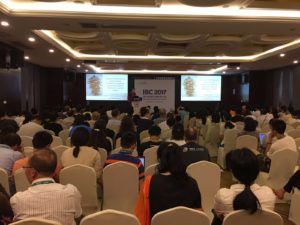

IBC amazing venue Jingjia Li’s poster at IBC

During my talk at IBC
Lots of traveling to great scientific meetings in June and July this year.
In June 19-22 I was in the lovely Melbourne, FL, to present our work on gene turnover rates at the 34th Southern Forest Tree Improvement Conference. It was a great opportunity to learn more about ongoing work in applying genetics and genomics to tree improvement. Also, it never hurts to be at a conference on the beach, although one can’t help but wondering about the impact of miles of resorts on a barrier island, particularly for the nesting activity of sea turtles.
A very difference meeting took place the first week of July in Austin. Postdoc Tomasz Koralweski and I traveled to our state capital to present two posters on convergent evolution in C4 grasses and in marine mammals (!) at the Annual Meeting of the Society of Molecular Biology and Evolution. The SMBE’s is one of my favorite meetings, and this year’s program was certainly not disappointing (program here). I cannot simply summarize the astonish amount of science that I have witnessed those 4 days, nor point to any specific highlight. It was great though to get some feedback about our current research, and to get inspired by some of the talks and posters we have seen.
Finally, at the end of July I traveled to Shenzhen, China, for the XIX International Botanical Congress. Almost 7,000 (!!) scientists convened to the South-eastern Chinese megacity, which was mostly built in the past 30 years across the border with Hong Kong, to discuss about anything botanical. IBC is a unique event, held every six years–the very first IBC was in Paris in 1900, although the conference stems from horticulture and botanical annual meetings that took place the first time in Brussels in 1864! It was quite an honor to give a short talk at IBC, even though it was the last talk of the last day. As usual with talks, it gave me the chance to re-think and improve our work on gene turnover rates in Pinaceae. Now we are wrapping up the paper–hopefully it will see the light later this year.
Jingjia Li, graduate student in the CasolaLab, also attended IBC and presented here work on the transcriptomic analysis of drough-tolerance in loblolly pine!
More info on the IBC can be found in the AoBBlog by Pat Heslop-Harrison and in the very detailed posts on Jeff Ollerton’s Biodiversity Blog (July 2017)